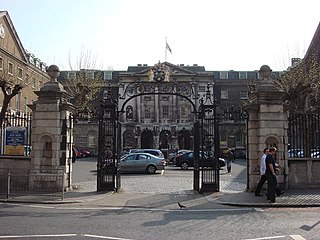Respondeat superior is a doctrine that a party is responsible for acts of his agents. For example, in the United States, there are circumstances when an employer is liable for acts of employees performed within the course of their employment. This rule is also called the master-servant rule, recognized in both common law and civil law jurisdictions.
Vicarious liability is a form of a strict, secondary liability that arises under the common law doctrine of agency, respondeat superior, the responsibility of the superior for the acts of their subordinate or, in a broader sense, the responsibility of any third party that had the "right, ability, or duty to control" the activities of a violator. It can be distinguished from contributory liability, another form of secondary liability, which is rooted in the tort theory of enterprise liability because, unlike contributory infringement, knowledge is not an element of vicarious liability. The law has developed the view that some relationships by their nature require the person who engages others to accept responsibility for the wrongdoing of those others. The most important such relationship for practical purposes is that of employer and employee.

English tort law concerns the compensation for harm to people's rights to health and safety, a clean environment, property, their economic interests, or their reputations. A "tort" is a wrong in civil law, rather than criminal law, that usually requires a payment of money to make up for damage that is caused. Alongside contracts and unjust enrichment, tort law is usually seen as forming one of the three main pillars of the law of obligations.
Economic torts, which are also called business torts, are torts that provide the common law rules on liability which arise out of business transactions such as interference with economic or business relationships and are likely to involve pure economic loss.
In the English law of tort loss of right is a new heading of potential liability arising as a matter of policy to counteract limitations perceived in the more traditional rules of causation.
Breaking the chain refers in English law to the idea that causal connections are deemed to finish. Even if the defendant can be shown to have acted negligently, there will be no liability if some new intervening act breaks the chain of causation between that negligence and the loss or damage sustained by the claimant.

London Drugs Ltd v Kuehne & Nagel International Ltd, [1992] 3 SCR 299 is a leading decision of the Supreme Court of Canada on privity of contract.

Fairchild v Glenhaven Funeral Services Ltd [2002] UKHL 22 is a leading case on causation in English tort law. It concerned malignant mesothelioma, a deadly disease caused by breathing asbestos fibres. The House of Lords approved the test of "materially increasing risk" of harm, as a deviation in some circumstances from the ordinary "balance of probabilities" test under the "but for" standard.
Economic torts in English law refer to a species of civil wrong which protects the economic wealth that a person will gain in the ordinary course of business. Proving compensation for pure economic loss, examples of an economic tort include interference with economic or business relationships.
Vicarious liability in English law is a doctrine of English tort law that imposes strict liability on employers for the wrongdoings of their employees. Generally, an employer will be held liable for any tort committed while an employee is conducting their duties. This liability has expanded in recent years following the decision in Lister v Hesley Hall Ltd to better cover intentional torts, such as sexual assault and deceit. Historically, it was held that most intentional wrongdoings were not in the course of ordinary employment, but recent case law suggests that where an action is closely connected with an employee's duties, an employer can be found vicariously liable. The leading case is now the Supreme Court decision in Catholic Child Welfare Society v Institute of the Brothers of the Christian Schools, which emphasised the concept of "enterprise risk".

Honeywill and Stein Ltd v Larkin Brothers Ltd [1934] 1 KB 191 is an English tort law case, establishing that employers may be vicariously liable for damage done by their independent contractors, where they carry out 'extra-hazardous' activities. Generally, employers are only vicariously liable for the torts of their employees, and not for those of independent contractors. However, a non-delegable duty may be imposed on an employer where they contract for inherently dangerous activities to be undertaken.

Rose v Plenty [1976] 1 WLR 141 is an English tort law case, on the issue of where an employee is acting within the course of their employment. Vicarious liability was tenuously found under John William Salmond's test for course of employment, which states that an employer will be held liable for either a wrongful act they have authorised, or a wrongful and unauthorised mode of an act that was authorised.

Mattis v Pollock [2003] 1 WLR 2158 is an English tort law case, establishing an employer's vicarious liability for assault, even where it may be intentional or pre-meditated. Previously, judges had been unwilling to impose liability where assaults were motivated by revenge or vengeance; it was established however that following the decision of Lister v Hesley Hall Ltd, that where an assault is closely linked to the duties of an employee, the employer should be held vicariously liable.

Morris v CW Martin & Sons Ltd [1966] 1 QB 716 is an English tort law case, establishing that sub-bailees are liable for the theft or negligence of their staff. Both Lord Denning and Diplock LJ rejected the idea that a contract need exist for a relationship of bailor and bailee to be found. Accordingly, it established an authority in vicarious liability, that employers are fully liable for the thefts - by employees - of goods that they have a duty to take care of.

Bazley v Curry, [1999] 2 SCR 534 is a Supreme Court of Canada decision on the topic of vicarious liability where the Court held that a non-profit organization may be held vicariously liable in tort law for sexual misconduct by one of its employees. The decision has widely influenced jurisprudence on vicarious liability outside of Canada.

Majrowski v Guy's and St Thomas' NHS Trust [2006] UKHL 34 is a UK labour law case holding that an employer will be vicariously liable for the harassment of an employee by another.
Dubai Aluminium Co Ltd v Salaam [2002] UKHL 48 is an English vicarious liability case, concerning also breach of trust and dishonest assistance.

Viasystems (Tyneside) Ltd v Thermal Transfer (Northern) Ltd[2005] EWCA Civ 1151 is an English tort law and UK labour law case, which held that a worker can have more than one employer at the same time, who will be vicariously liable for the worker.
K v Minister of Safety and Security is an important case in the South African law of delict and South African constitutional law. It was heard by the Constitutional Court on May 10, 2005, with judgment handed down on June 13. Langa CJ, Moseneke DCJ, Madala J, Mokgoro J, O'Regan J, Sachs J, Skweyiya J, Van der Westhuizen J and Yacoob J presided. W. Trengove SC appeared for the applicant; PF Louw SC appeared for the respondent. The applicant's counsel was instructed by the Women's Legal Centre, Cape Town. The respondent's attorney was the State Attorney, Johannesburg.
Catholic Child Welfare Society v Institute of the Brothers of the Christian Schools [2012] UKSC 56 is an English tort law case, concerning vicarious liability.









